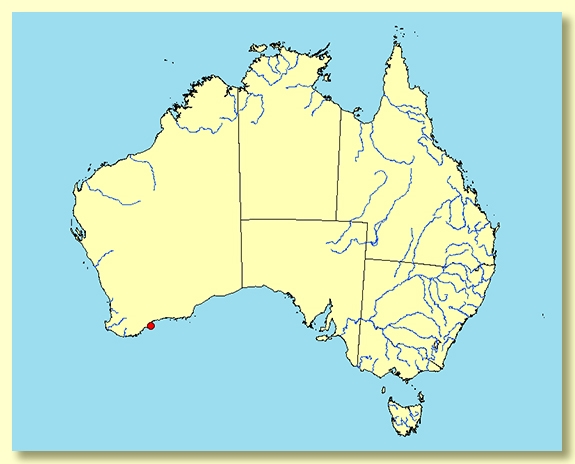Eucalyptus | Symphyomyrtus | Bisectae | Hadrotes | Lehmannianae | Conjunctae
Euclid - Online edition
Eucalyptus retusa
Mallee or shrub up to 4 m tall. Forming a lignotuber.
Bark smooth throughout, cream, grey-brown and pale grey.
Branchlets lack oil glands in the pith.
Juvenile growth (coppice or field seedlings to 50 cm): not seen.
Adult leaves alternate, petioles 0.2–0.5 cm long; blade obovate, thick-textured, 3–5.5 cm long, (1.1)1.4–2.1 cm wide, base tapering to petiole, margin entire, apex usually rounded or emarginate (retuse) with a warty apiculum, concolorous, glossy, green, reticulation ? moderate, intramarginal veins prominent and remote from margin, oil glands ? numerous.
Inflorescence axillary unbranched, peduncles angular-terete, erect, 4.5–10(14) cm long; buds 13–19 per umbel which is syncarpous, pedicels absent. All the buds in an umbel are joined by the lower fifth to half of the hypanthium only, the upper part of each bud remains free; at maturity the combined length of the fused part plus operculum is ca 4–5 cm. Scar left by the early shedding of the outer (sepaline) operculum is difficult to see; inner (petaline) operculum slightly curved with a few small warts at tip, 5 to 8 times as long as the fused part of the bud (the inner operculum at maturity is ca 4 cm long and is widest at its base being ca 0.5 cm); stamens completely erect, anthers narrowly oblong, versatile, dorsifixed, dehiscing by longitudinal slits, style long and straight, stigma ?blunt, locules 3, the number of vertical rows of ovules not known. Flowers green-yellow.
Fruit on erect peduncles, syncarpous, the individual capsules united basally forming a woody mass, the individual capsules cupular or obconic, ca 0.8 cm long and 0.7–1 cm wide, dehiscing by elliptical holes formed as the 3 valves split along the sutures but remain ± connected apically, disc covers the surface of the valves.
Seeds not seen.
Cultivated seedlings (measured at node 10): not grown by us. From the original description cotyledons Y-shaped (bisected); leaves always petiolate, opposite ca 2-3 nodes then alternate, ovate to orbicular ovate, to 5 cm long, to 4 cm wide, dull pale green, slightly discolorous, lamina scabrous.
Flowering time not recorded.
Shrub or smooth-barked low mallee endemic to the southern coast of Western Australia near Bremer Bay where confined to an exposed headland. A readily distinguished species with glossy green obovate adult leaves and partially fused buds in axillary clusters. The buds have opercula ca 4 cm long and when in flower form greenish yellow balls.
Eucalyptus retusa belongs in Eucalyptus subgenus Symphyomyrtus section Bisectae subsection Hadrotes because the cotyledons are coarsely Y-shaped, buds have an operculum scar, a long (inner) operculum and erect stamens, fruit which are large, thick-rimmed and held rigidly on the peduncles. Of the twelve species in subsection Hadrotes ten lack oil glands in the pith of the branchlets and have scabrid seedlings. Together these ten species form series Lehmannianae, a group further characterised by having fruit with exserted valves that remain fused at their tips after seed shed, a feature shared with the more distantly related E. cornuta.
Of the ten species in series Lehmannianae six, E. conferruminata, E. lehmannii, E. mcquoidii, E. arborella, E. sinuosa and E. retusa have the buds (and fruit) in each axillary cluster fused basally (forming subseries Conjunctae), whilst the other four species, E. newbeyi, E. burdettiana, E. talyuberlup, and E. megacornuta, have buds and fruit free (forming subseries Liberae).
E. retusa differs from its five close relatives by its short stiff obovate leaves 3–5.5 cm long and with rounded or notched apex, buds not as completely fused basally in the clusters, and relatively short opercula. All other species have linear to elliptical or narrowly lanceolate adult leaves, buds completely fused up to the join with the operculum and generally longer opercula at bud maturity.
Eucalyptus retusa: from Latin retusus meaning not sharp, blunt, having a broad or rounded end with apical notch or indentation; referring to the adult leaf.






